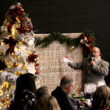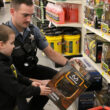Ken Roberts
For The New Era
For Coach Rob Younger, the East-West Shrine game is much more than the game itself.
By virtue of Sweet Home’s Capital Conference championship last year, Younger had his second opportunity to head up the East staff. The head coaching position is assigned on a rotating basis with the other four 3A conferences, so every four years the Capital Conference sends its representative. Younger was in the same position in 1991, when he coached the East to a 29-7 victory.
But the victory is relatively unimportant to Younger; it’s the cause that makes the difference.
The Shriners organization combines with Baker and Union County to put on this charity event, which turns out to be quite a huge production. Starting Thursday, July 1st, the the 60 players and six coaches, 30 players and three coaches for each side, gathered at the Wilsonville Shriners Lodge for a barbecue.
On Friday after a breakfast and orientation, the players were issued their uniforms and then hopped on charter buses for a morning at the Shriners Hospital.
“I like that we make the visit the very first thing,” said Younger, “because it has a very sobering effect and brings perspective over what we’re going to do in the next eight days.”
During this visit, they watched a video explaining the purpose of the game and the Shriners Hospital. Stan Brock, a former NFL player from Oregon, was the spokesman for the event.
After that, they toured the hospital, giving the players and coaches time to interact with the patients, taking pictures and signing autographs.
“Sometimes we take our health for granted,” said Younger. “All of a sudden, you are exposed to somebody that was born with a physical handicap or something. It’s amazing to see the joy and the enthusiasm that those young patients had for our players. It really made our players feel good.”
This game that brings together top-notch players from the eight man teams of the 1A division and the small schools of the 2A and 3A divisions in Oregon is the second highest athletic money-raising event for the Shriners in the United States, second only to the East-West college game. This event held annually in Bulldog Stadium in Baker City has averaged over $75,000 a year over the last ten years. The 4A event in Portland lost money and had to be taken over by the OSAA to continue to give the 4A players an opportunity to play.
Past players in this event continue to contribute donations in the amount of $7,000 to $9,000 a year to show their appreciation and support for the Shriners. Dustin Nichol, the defensive coordinator for the Huskies and a member of the 1991 East team, called the players on that team during the 50th anniversary of the event to put together enough money to sponsor a full page advertisement in the program thanking the Shriners for their experience. Many of those players continue to donate.
After the hospital visit, the teams were bused to LaGrande where they were housed. Eastern Oregon University provided their facilities and trainers for practices that began Saturday. The players also attended other events during their stay in LaGrande, starting with the Union County Fair. Another highlight was the players banquet, where the players were introduced and recognized for their various high school awards and activities. Baker City businesses each sponsor one of the athletes and display the different things sent in by the athletes, which the players of the East viewed on Wednesday.
The coaches were treated to some golf with some of the Shriners on Tuesday. Coach Younger said he led his group with an 89, but with his method of scoring, it was probably the most disputed call until some of the officials’ calls on fumbles during the football game itself.
From the first meeting, and then watching his players interact at the different events and throughout the practices, Coach Younger was impressed with the quality of their collective character. Character was a part of the selection process in the first place. Younger made 75 to 100 phone calls to verify the character of the nominated athletes to make sure he would have players who would represent their schools and communities well. Of the 30 who were selected, 27 were national honor society members, two were valedictorians, and three were salutatorians.
This along with an impressive list of other honors brought together an outstanding group of student athletes, not just athletes.
Not only did they pick up the offensive and defensive schemes quickly with their intelligence, they also bought in to the idea of a brotherhood that Younger hoped to impart. He was amazed at the number of players who came up to him and said there wasn’t a player on the team that they didn’t like.
“I’ve never been associated with a group of young men that came together in relationships the way this group did,” said Younger.
He brought up an example of their character that came out during their first meal together.
When he saw one player sitting by himself, Younger suggested to some of the players that they go ask him to join them. When the player declined at first, the whole table of players came over and sat at his table 15 seconds later.
“They did things together,” said Younger. “They talked a lot about it (the idea of a brotherhood). They were very open to that.”
The strong relationships spilled over onto the practice field. Younger committed himself to playing the players evenly, half the time on offense and half the time on defense. And it paid off.
“Kids knew they were going to play,” said Younger. “It increased practice intensity and focus.”
It also kept them well-rested and allowed them to play up to their ability during the game.
Perhaps from a slightly prejudiced point of view, it seemed that this group of brothers brought that intensity to the game, making the bigger hits, the bigger plays, and the greater spirit. One player started a chant for the defense in a crucial situation, calling the defense the Big Red Wall.
Coach Younger felt the vigor of that intensity as one of his own players raced to the sidelines, making an unsuccessful attempt to haul in an overthrown pass, meanwhile taking Younger out at the back of the knees. Down goes Younger.
“I lost my focus,” said Younger, thankful that the medics were not required.
That was the second time he came close to requiring a medical procedure. The first was at the start of the game as he ran down the hill at the entrance to the field and continued down the sideline.
“I need air,” said the huffing-puffing Younger. Part of the problem was the ample provisions provided by the hosts throughout the week. But maybe the other factor was an adrenalin rush that comes with coaching football and especially this group of kids.
“Standing out there with those players as they were being introduced, singing the national anthem, there’s no question that the chest was pumped out a little bit,” said Younger. “I felt very humble to be able to be exposed to an experience like that.”
From past experience, he knows this will last beyond the eight days. He still receives phone calls and E-mails from players and coaches on the 1991 team. For this team, Younger could cite a special story about each player. That’s how deep the relationships became.
He anticipates the phone calls and E-mails that will surely follow from this team.




